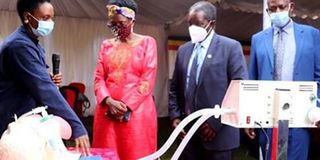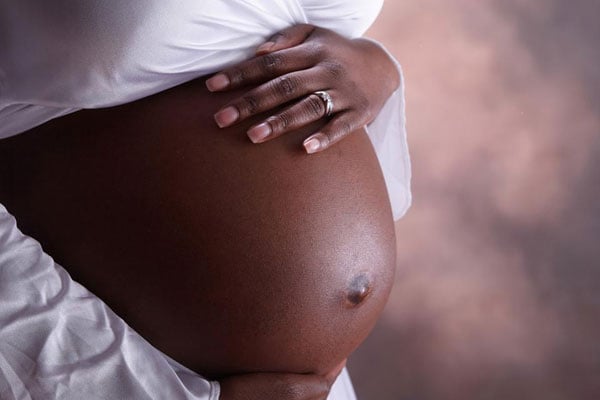Makerere’s low-cost ventilator ready to assist Covid-19 patients

Health minister, Dr Jane Ruth Aceng (2nd left), and Makerere Deputy Vice Chancellor for finance and administration, Prof William Bazeyo (right), during the unveiling of the ventilator in Kampala on June 11. PHOTO | FILE
Innovators across the country are coming up with quality but inexpensive alternatives to products that were being imported.
Ventilators for managing Covid-19 patients is one of them. Ventilators are used on patients who have signs of breathing failure, a likely scenario with Covid-19 patients.
Experts at Makerere University in collaboration with Kiira Motors Corporation (KMC) have manufactured a gadget dubbed ‘Bulamu Ventilator’ whose components are sourced locally.
The machine, according to manufacturers, is to be sold at $3,000 (Shs11m) compared to $25,000 (Shs93m) for imported ones.
Mr Allan Muhumuza, the business development manager at KMC, says the project has passed engineering tests and that experts at Makerere University medical school are now testing it for endurance and compliance to the field.
He says this will be followed by a clinical trial on animals led by a team of scientists from Makerere University College of Veterinary Medicine, Animal Resources and Bio-Security.
“The scientists at Makerere University veterinary school are developing a protocol for trial on animals which will begin next month. After that, clinical trial on humans will be done,” Mr Muhumuza said yesterday.
Usually a clinical trial takes around six months but Mr Muhumuza said government will shorten the duration to ensure the much-needed life support the machine is availed in time.
Mr Paul Musasizi, the central executive officer of KMC, said the machine will be installed in ambulances, intensive care units (ICUs) in hospitals and other settings.
“The design has been majorly done to make it a touch screen to ensure it doesn’t become a disease vector. We worked with Victoria Engineering Ltd for the fabrication and casing,” Mr Musasizi added.
The operating system was developed by a young scientist who owns a startup firm called Billy Applied Electronics and ICT Centre in Kampala.
The engineers at Kiira Motors and Makerere University have done mechanical engineering design, electronic design and architectural styling.
Machine features
With its operating system enclosed in a metallic casing, the machine has tubes and touch screen interface to adjust settings. The Bulamu Ventilator has an electrical and mechanical architecture, which utilises motors, air pressure transducers and airflow transducers to function.
A transducer is a device that converts variations in a physical quantity, such as pressure or brightness, into an electrical signal, or vice versa.
The machine also has inhalation and exhalation control valves, air compression and the inbuilt monitoring systems.
Ms Pauline Korukundo, who is one of the experts in Bulamu Ventilator development, said the machine has an internal electronic control system that regulates its entire operation.
The expert reveals that the machine uses electricity but also has a backup battery system which makes it fit to be used even in rural areas.
“The battery can work for more than two hours. We also have a solar charge controller so you can use solar or main electrical supply depending on where you are, to charge the battery,” she said.
The machine is designed to carry alongside, a “test lung” where the machine is tested all the time before the pipes from the machine are placed into a person to aid them to breathe.
“We have a ‘test lung’ where the machine is tested first before being connected to the patient to ensure everything is working perfectly,” Ms Korukundo said.
After trying on the test lung, the pipes can now be inserted into the person who has breathing difficulty. The settings of the machines can also be adjusted to suit how much breathing support a patient needs.
“We can set the parameter for the ventilation depending on the patient before starting the ventilation,” Ms Korukundo said.
The expert said the machine is highly sensitive to malfunctions and will alert the user to eliminate risk to the patient during ventilation.
Minister speaks
Dr Jane Ruth Aceng, the Health minister, while unveiling the machine last week, said it is timely that the manufacturers developed the ventilators.
“We will need ventilators in hospital setups to cater for 20 per cent of patients who progress to severe conditions. At the regional referrals, we have worked hard to ensure each of them has 10 ICU beds and definitely we need ventilators in each of them,” Dr Aceng said.




